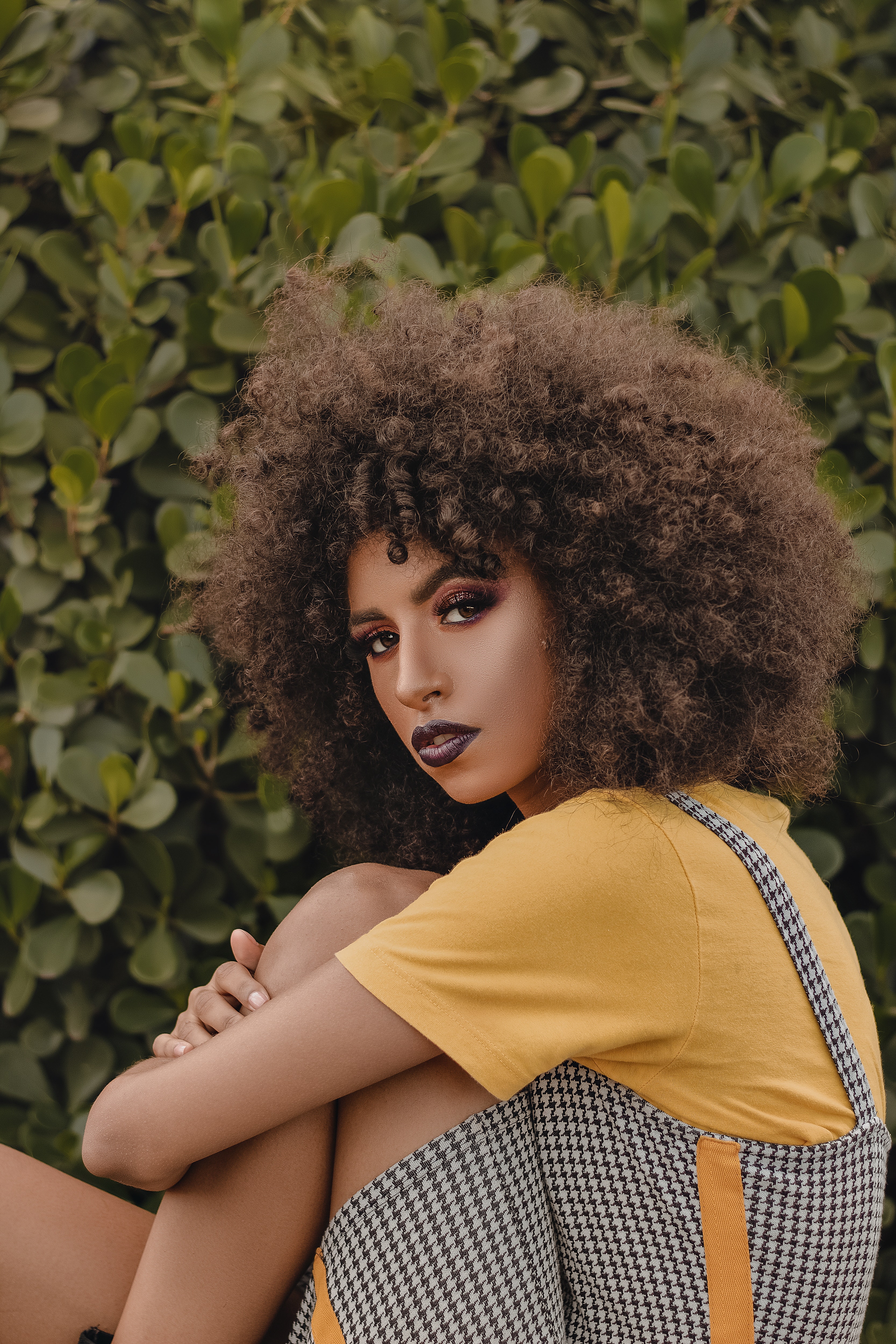HOLIDAY OFFERS: Save 15% sitewide


Whether you wear your kinky, coily hair natural, straightened, or in protective styles, all textured hair is especially prone to dryness and breakage.
To help you restore hydration and establish a successful natural hair routine, we’ve consulted celebrity hairstylist and OurX master hair educator, Johnny Wright, who’s worked with Michelle Obama, Tamron Hall, and Kerry Washington. Keep reading for his immediate solutions to prevent future breakage and stimulate new growth.

Symptoms Of Damaged Natural Hair
When hair is extremely dry, “it doesn’t retain any moisture and is rough to the touch,” says Wright. Other symptoms include:
- Split ends that break off easily
- Excess shedding
- Brittle, limp strands
- Loosening of natural curl pattern

Causes Of Damaged Natural Hair
Textured hair is so versatile, so identifying the root cause of dry hair can be tricky. Some common culprits are:
- Heat styling
- Harsh chemicals like relaxers and hair coloring
- Lack of maintenance and manipulation
- Products with harmful ingredients

How To Fix Damaged Kinky, Coily Hair
1. Use a shampoo for damaged hair
Although coily hair can be shampooed less frequently, a weekly wash day routine is essential for removing product build-up, dead skin, and impurities. Opt for a hydrating shampoo, like the OurX Nutrient Cleanse Complex, loaded with active ingredients to gently cleanse and replenish hair from root to tip without stripping it of natural oils. As you lather, “take the time to massage the scalp area so you can really clean those pores and stimulate circulation to promote growth” instructs Wright. Freshly washed hair should always “leave hair feeling moisturized and soft to the touch without making your scalp itchy.”
2. Apply a deep conditioner for damaged hair
After cleansing, apply a restorative conditioner for 10-15 minutes, like the high-performance OurX Intensive Conditioning Compound, to replenish and lock in moisture. The deep conditioning formula will deeply penetrate and smooth the hair cuticle to visibly improve texture and frizz, leaving you with shinier, healthier locks.
3. Use hair treatments for damaged hair
When your hair needs a little extra TLC, the OurX Treatment Leave-In conditioner is an ultra-nourishing, cream leave-in conditioner that you can apply following your wash routine. The buttery, lightweight formula melts into the hair shaft to improve moisture retention, so detangling and styling are a breeze.
4. Get regular trims
To maximize hair health and retain length, scheduling regular trims every 6-12 weeks is imperative. Wright instructs to be observant of split ends and signs of breakage, in case a big chop is necessary. “When you start seeing shorter strands, that represents some type of abrasion and an indication of damaged hair. Use the shortest length as a sign of demarcation and cut your hair to that point. Then start treating your hair from there”.
5. Wear a protective style
Whether it’s braids, twists, weaves, or wigs, we all love a low-maintenance protective do’ that gives us a break from daily styling and boosts hair growth. However, be wary of styles that painfully tug on the scalp and edges, due to tight installation or heavy extensions. The tension can strain hair follicles, resulting in traction alopecia and thinning. Additionally, “Neglecting the upkeep of a protective style can be detrimental for scalp health, so don’t skip washes. Be diligent about removing your style every 4-5 weeks to avoid an itchy scalp and let your hair breathe” details Wright.
6. Avoid heat styling
Overusing heat styling tools can alter your hair’s protein structure, destroy elasticity, and weaken the hair’s outer layer, called the hair cuticle. As a result, your hair becomes even more vulnerable to damage, dehydration, split ends, and dullness. Unfortunately, once the hair structure is damaged, it cannot be restored. The best course of action is giving the flat irons and blow drying a break, and committing to a big chop or slowly cutting off the ends. If you plan to use heat tools in the future on new growth, Wright recommends, “always use heat protectant and aim to only use hot tools once a week …always under 300°F.”
7. Get rid of products containing harmful ingredients
Switching up your daily hair care products also plays a major role in preventing damage. Toss any products containing harmful ingredients like denatured alcohols, sulfates, parabens, and silicones, among others. Not only are some of these toxic, but they also deplete your hair and scalp of natural oils, leaving it dry and brittle.
As an alternative, OurX’s product line only uses clean and conscious ingredients, including Niacinamide, a water-soluble form of vitamin B3, highly effective in repairing damaged hair from the inside out. The multi-masking nutrient is proven to boost blood circulation, reduce hair loss, lock in moisture, improve hair texture and thickness, and regulate oil on the scalp.
8. Eat a healthy diet
Your diet can play a major role in restoring fullness, so make an effort to consume some of these highly-nutritional foods daily. In addition to eating a variety of fiber and antioxidant foods like leafy greens, loading up on healthy fats like salmon, avocados, and nuts are great sources of Omega-3. Both food groups are essential for hair shine and density. Also incorporate protein-rich foods like eggs and lean chicken, which are highly effective for hair growth.
9. Take hair vitamins
If you notice your hair is losing its luster, vitamin and mineral deficiencies may be the culprit. The good news is that common deficiencies linked to hair loss, like vitamin D, iron, and zinc, are easily reversible with the right supplements. If your vitamin levels are sufficient, hair growth vitamins may be the remedy for thicker, fuller hair. Look for an option loaded with biotin, which has been proven in clinical studies to support growth, add sheen to your driest strands, and even nourish the scalp. Just be sure to consult your doctor before switching up your vitamin intake.
10. Drink plenty of water
If you notice an increase of thinning tresses, excessive shedding, a dry scalp, and brittle nails, it may indicate that you are severely dehydrated. When your body is lacking adequate levels of h2O, hair damage and loss may be accelerated. To prevent future damage and lubricate your strands, aim to drink at least 64 ounces of water daily and eat more water-based foods like fresh fruits and veggies. Also, reduce your caffeine and alcohol consumption, as both are diuretics and contribute to dehydration.
11. Sleep on a silk pillowcase
Silk or satin pillowcases are an underrated tool for keeping hair moisturized and soft, overnight. Unlike traditional cotton linens, “The silky material doesn’t create any friction or disturb the hair texture” explains Wright. The material is also effective in preserving your style, so you won’t have to risk your bonnet or scarf falling off, making your morning prep a breeze. “You’ll notice way less frizz, and tangles, and wake up with your curls and edges curls intact” notes Wright. “Try pinning your curls in a high pineapple ponytail. When you wake up, just fluff out your hair and you’re good to go.”

FAQs
How do you restore kinky hair? To maintain the health of kinky hair, it is essential to restore hydration. Use moisturizing products and apply a nourishing deep conditioner at least once a week. Avoid using heat tools and harsh chemicals, don’t leave protective styles in too long, and get regular trims every 3-4 months.
Can you repair badly damaged hair? When damaged hair is beyond repair, it no longer retains moisture, is rough to the touch, and breaks easily. Cutting off the parched hair and starting fresh is the best way to improve your hair health and fullness.
Can damaged 4C hair grow? Regular trims that remove split ends and damaged 4C hair are essential to help kinky hair grow. Prioritize your scalp health and avoid using any tools, including curling irons, flat irons, and blow dryers, on the remaining healthy hair to promote growth.
What does damaged hair look like for natural hair? Damaged natural hair looks extremely dry with split ends and has a loosened curl pattern. It feels brittle, sounds crunchy, and causes breakage


